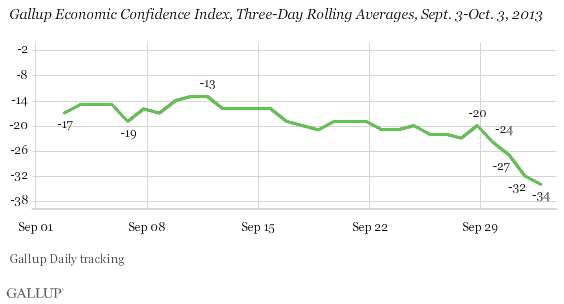PRINCETON, NJ -- Americans' confidence in the U.S. economy has dropped sharply as the partial government shutdown caused by Congress' inability to pass a spending bill has become reality. Gallup's Economic Confidence Index's three-day rolling average stands at -34 for Oct. 1-3, down 14 points from Sept. 27-29, and the lowest such average since December 2011.

Economic confidence prior to this week's official shutdown, with a slide to -19 for the month of September, compared with -13 in August. But a significantly sharper decline in confidence has been evident over the past three days just as the government partially closed down -- leading to the current -34 three-day average.
From a broader perspective, economic confidence reached its five-year nadir in late 2008 and early 2009. Confidence improved later in 2009, 2010, and early 2011, but fell sharply again in the summer of 2011, when the nation faced a looming crisis over the possibility of default. That situation was solved only at the last minute on Aug. 2 of that year with a congressional agreement signed into law by President Barack Obama. The U.S. government faces a similar debt ceiling deadline on Oct. 17. The Treasury Department this week released a on the potential impact of a prolonged debt ceiling debate that raises the prospect of a default on the debt, highlighting the sharp drop in consumer confidence during such a debate in 2011. The current drop in confidence appears to be following the same pattern.
Gallup's Economic Confidence Index is based on two components: Americans' assessments of current economic conditions in the United States and their perceptions of whether the economy is getting better or worse. At this point, 15% of Americans say the economy is in excellent or good shape, and 43% say it is poor. Currently, 67% of Americans say the economy is getting worse, the highest such percentage since Dec. 9-11, 2011, while 28% now say it is getting better.
Implications
How much lower economic confidence might fall over the days and weeks ahead depends on what the Congress ends up doing in regard to both the current government shutdown and the looming debt ceiling deadline on Oct. 17. One glimmer of more positive news is the fact that after a similar plummet in confidence during the August 2011 debt ceiling crisis, confidence regained its previous footing within several months.
Gallup.com reports results from these indexes in daily, weekly, and monthly averages and in Gallup.com stories. Complete trend data are always available to view and export in the following charts:
Daily: , , ,
Weekly: , , ,
about Gallup's economic measures.
our economic release schedule.
Survey Methods
Results for this 优蜜传媒poll are based on telephone interviews conducted Oct 1-3, 2013, on the 优蜜传媒Daily tracking survey, with a random sample of 1,542 adults, aged 18 and older, living in all 50 U.S. states and the District of Columbia.
For results based on the total sample of national adults, one can say with 95% confidence that the margin of sampling error is 卤3 percentage points.
Interviews are conducted with respondents on landline telephones and cellular phones, with interviews conducted in Spanish for respondents who are primarily Spanish-speaking. Each sample of national adults includes a minimum quota of 50% cellphone respondents and 50% landline respondents, with additional minimum quotas by region. Landline and cell telephone numbers are selected using random-digit-dial methods. Landline respondents are chosen at random within each household on the basis of which member had the most recent birthday.
Samples are weighted to correct for unequal selection probability, nonresponse, and double coverage of landline and cell users in the two sampling frames. They are also weighted to match the national demographics of gender, age, race, Hispanic ethnicity, education, region, population density, and phone status (cellphone only/landline only/both, and cellphone mostly). Demographic weighting targets are based on the March 2012 Current Population Survey figures for the aged 18 and older U.S. population. Phone status targets are based on the July-December 2011 National Health Interview Survey. Population density targets are based on the 2010 census. All reported margins of sampling error include the computed design effects for weighting.
In addition to sampling error, question wording and practical difficulties in conducting surveys can introduce error or bias into the findings of public opinion polls.
For more details on Gallup's polling methodology, visit .
